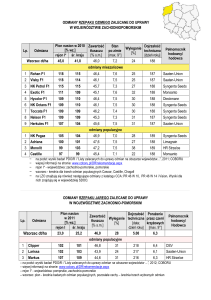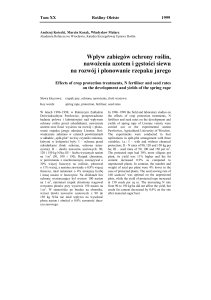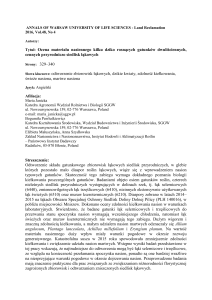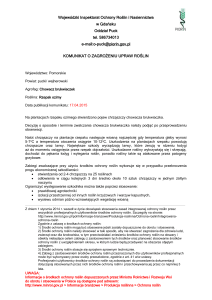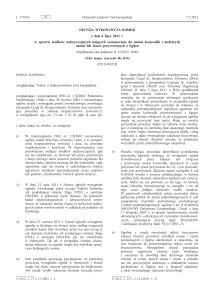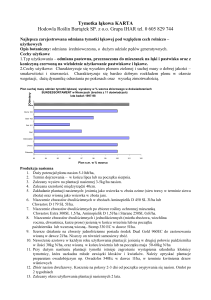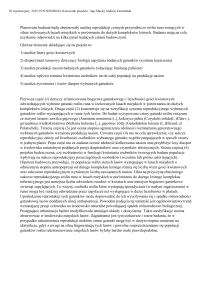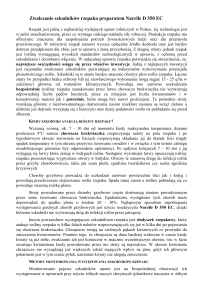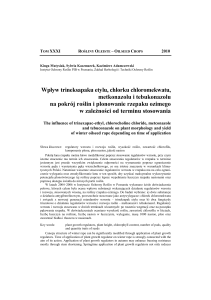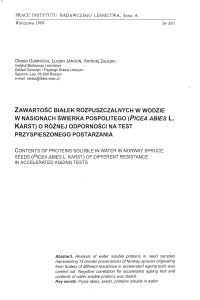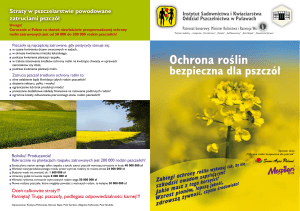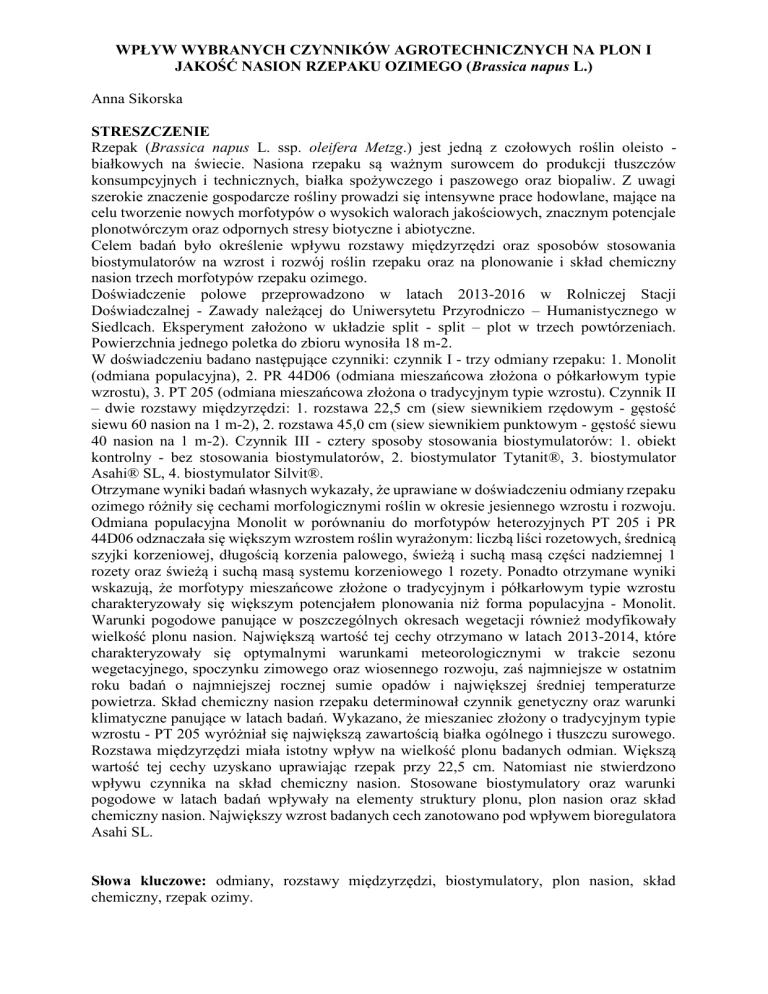
WPŁYW WYBRANYCH CZYNNIKÓW AGROTECHNICZNYCH NA PLON I
JAKOŚĆ NASION RZEPAKU OZIMEGO (Brassica napus L.)
Anna Sikorska
STRESZCZENIE
Rzepak (Brassica napus L. ssp. oleifera Metzg.) jest jedną z czołowych roślin oleisto białkowych na świecie. Nasiona rzepaku są ważnym surowcem do produkcji tłuszczów
konsumpcyjnych i technicznych, białka spożywczego i paszowego oraz biopaliw. Z uwagi
szerokie znaczenie gospodarcze rośliny prowadzi się intensywne prace hodowlane, mające na
celu tworzenie nowych morfotypów o wysokich walorach jakościowych, znacznym potencjale
plonotwórczym oraz odpornych stresy biotyczne i abiotyczne.
Celem badań było określenie wpływu rozstawy międzyrzędzi oraz sposobów stosowania
biostymulatorów na wzrost i rozwój roślin rzepaku oraz na plonowanie i skład chemiczny
nasion trzech morfotypów rzepaku ozimego.
Doświadczenie polowe przeprowadzono w latach 2013-2016 w Rolniczej Stacji
Doświadczalnej - Zawady należącej do Uniwersytetu Przyrodniczo – Humanistycznego w
Siedlcach. Eksperyment założono w układzie split - split – plot w trzech powtórzeniach.
Powierzchnia jednego poletka do zbioru wynosiła 18 m-2.
W doświadczeniu badano następujące czynniki: czynnik I - trzy odmiany rzepaku: 1. Monolit
(odmiana populacyjna), 2. PR 44D06 (odmiana mieszańcowa złożona o półkarłowym typie
wzrostu), 3. PT 205 (odmiana mieszańcowa złożona o tradycyjnym typie wzrostu). Czynnik II
– dwie rozstawy międzyrzędzi: 1. rozstawa 22,5 cm (siew siewnikiem rzędowym - gęstość
siewu 60 nasion na 1 m-2), 2. rozstawa 45,0 cm (siew siewnikiem punktowym - gęstość siewu
40 nasion na 1 m-2). Czynnik III - cztery sposoby stosowania biostymulatorów: 1. obiekt
kontrolny - bez stosowania biostymulatorów, 2. biostymulator Tytanit®, 3. biostymulator
Asahi® SL, 4. biostymulator Silvit®.
Otrzymane wyniki badań własnych wykazały, że uprawiane w doświadczeniu odmiany rzepaku
ozimego różniły się cechami morfologicznymi roślin w okresie jesiennego wzrostu i rozwoju.
Odmiana populacyjna Monolit w porównaniu do morfotypów heterozyjnych PT 205 i PR
44D06 odznaczała się większym wzrostem roślin wyrażonym: liczbą liści rozetowych, średnicą
szyjki korzeniowej, długością korzenia palowego, świeżą i suchą masą części nadziemnej 1
rozety oraz świeżą i suchą masą systemu korzeniowego 1 rozety. Ponadto otrzymane wyniki
wskazują, że morfotypy mieszańcowe złożone o tradycyjnym i półkarłowym typie wzrostu
charakteryzowały się większym potencjałem plonowania niż forma populacyjna - Monolit.
Warunki pogodowe panujące w poszczególnych okresach wegetacji również modyfikowały
wielkość plonu nasion. Największą wartość tej cechy otrzymano w latach 2013-2014, które
charakteryzowały się optymalnymi warunkami meteorologicznymi w trakcie sezonu
wegetacyjnego, spoczynku zimowego oraz wiosennego rozwoju, zaś najmniejsze w ostatnim
roku badań o najmniejszej rocznej sumie opadów i największej średniej temperaturze
powietrza. Skład chemiczny nasion rzepaku determinował czynnik genetyczny oraz warunki
klimatyczne panujące w latach badań. Wykazano, że mieszaniec złożony o tradycyjnym typie
wzrostu - PT 205 wyróżniał się największą zawartością białka ogólnego i tłuszczu surowego.
Rozstawa międzyrzędzi miała istotny wpływ na wielkość plonu badanych odmian. Większą
wartość tej cechy uzyskano uprawiając rzepak przy 22,5 cm. Natomiast nie stwierdzono
wpływu czynnika na skład chemiczny nasion. Stosowane biostymulatory oraz warunki
pogodowe w latach badań wpływały na elementy struktury plonu, plon nasion oraz skład
chemiczny nasion. Największy wzrost badanych cech zanotowano pod wpływem bioregulatora
Asahi SL.
Słowa kluczowe: odmiany, rozstawy międzyrzędzi, biostymulatory, plon nasion, skład
chemiczny, rzepak ozimy.
THE IMPACT OF THE SELECTED AGROTECHNICAL FACTORS ON THE
YIELD AND QUALITY OF THE SEEDS OF WINTER RAPE
(Brassica napus L.)
Anna Sikorska
ABSTRACT
Rape (Brassica napus L. ssp. oleifera Metzg.) is one of the leading oily-protein plants in the
world. Rapeseeds are an important raw material for the production of consumable and technical
fats, food and feed protein, and bio-fuels. Due to the wide economic importance of the plant,
intensive breeding works are conducted, which aim at the creation of new morphotypes with
high quality values, significant plan potential and resistant to biotic and abiotic stresses.
The aim of the study was to determine the impact of the spacing of interrows and the methods
of using bio-stimulators on the growth and development of rape and on the yield and chemical
composition of seeds of three morphotypes of winter rape.
The field experiment was conducted in the years 2013-2016 at the Agricultural Experimental
Station – Zawady, which belongs to the University of Natural Sciences and Humanities in
Siedlce. The experiment was set in the system split - split - plot in triplicate. The area of one
plot for harvest was 18 m-2.
The experiment studies the following factors: factor I - three rape varieties: 1. Monolit
(population variety), 2. PR 44D06 (hybrid complex variety with a semi-dwarf growth type), 3.
PT 205 (hybrid complex variety with a traditional growth type). Factor II - two interrows
spacing: 1. spacing 22,5 cm (sowing with a row seeder - sowing density 60 seeds per 1 m-2),
2. spacing 45,0 cm (sowing with a point seeder - sowing density 40 seeds per 1 m-2). Factor III
- four ways of using bio-stimulators: 1. control object - without using bio-stimulators, 2. biostimulator Tytanit®, 3. bio-stimulator Asahi® SL, 4. bio-stimulator Silvit®.
The obtained results of own studies showed that the types of winter rape grown in the
experiment were different in terms of morphological features from the plants in the autumn
period of growth and development. The population variety Monolit, compared to the heterosis
morphotypes PT 205 and PR 44D06, characterised by greater plant growth expressed in: the
number of rosette leaves, the diameter of the root collar, the length of the tap root, fresh and dry
mass of the aboveground part of 1 rosette and fresh and dry mass of the root system of 1 rosette.
In addition, the obtained results indicate that the hybrid complex morphotypes with a traditional
and semi-dwarf growth type characterised by the greater planning potential than the population
form - Monolit. The weather conditions in different growing periods have also modified the
size of the seed yield. The greatest value of this trait was obtained in the years 2013-2014,
which were characterised by the optimal weather conditions during the growing season, winter
dormancy and spring development, while the smallest in the last year of studies with the
smallest annual total rainfall and the highest average air temperature. The chemical composition
of rapeseed was determined by the genetic factor and the climatic conditions in the years of the
study. It has been shown that the complex hybrid with a traditional growth type - PT 205 was
distinguished by the highest content of overall protein and raw fat. The interrows spacing had
a significant impact on the yield of the studied cultivars. The greater values of this feature was
obtained by growing rape with 22,5 cm. In contrast, no effect of the factor on the chemical
composition of the seeds was stated. The applied bio-stimulators and weather conditions in the
years of the study affected the elements of the yield structure, seed yield and chemical
composition of seeds. The largest increase of the studied features was noted under the influence
of the bio-regulator Asahi SL.
Keywords: varieties, interrows spacing, bio-stimulators, seed yield, chemical composition,
winter rape.

